In the realm of energy storage technology, lithium-ion batteries (LIBs) have surged to prominence, powering everything from handheld devices to electric vehicles. However, as these systems become increasingly indispensable, extensive research is underway to understand their intricacies and optimize their performance. A groundbreaking study by a team of researchers, led by P. Li, presents a novel multi-scale electrochemical-thermal–mechanical coupling model for lithium-ion batteries, which can significantly enhance our understanding of battery performance and longevity under various operating conditions. This innovative model stands on the layer-wise theory, which proposes a detailed analysis of the interactions within each layer of the battery structure.
The need for such comprehensive modeling stems from the complex nature of lithium-ion batteries, where electrochemical processes occur simultaneously with thermal and mechanical changes. Traditional approaches often isolate these processes, leading to incomplete insights about battery behavior. The new model developed by Li and colleagues integrates these fundamental aspects, allowing for a more holistic view of the phenomena influencing battery health and efficiency. This integration provides crucial information for the design and operation of batteries, particularly under stressful conditions such as rapid charging and extreme temperatures.
The electrochemical component of the model analyzes the transport of lithium ions and the resulting reactions at the electrodes. It highlights how reaction kinetics and concentration gradients can influence overall battery performance, revealing that even minor deviations in these parameters can lead to significant impacts on efficiency and thermal stability. Understanding these kinetics provides a vital framework for engineers and researchers looking to enhance energy density and cycle life in future battery systems.
Thermal management is critical in maintaining battery safety and performance; the model addresses this by examining heat generation during battery operation. As batteries charge and discharge, varying rates of heat generation can lead to different temperature gradients within the cell. This thermal analysis is crucial since overheating can result in thermal runaway, a dangerous condition that can damage the battery and pose safety risks. The study meticulously quantifies these heat generation rates, shocking those familiar with traditional safety thresholds, and lays the groundwork for future cooling system designs and thermal management strategies.
The model’s mechanical coupling adds another layer of sophistication, focusing on how internal stresses evolve due to temperature changes and electrochemical reactions during cycling. As lithium ions move into the electrode material, volumetric changes occur, inducing mechanical strain. Such strain can lead to microcracking and, ultimately, failure of the battery. The team’s analysis of stress-strain relationships emphasizes the importance of materials engineering, advocating for the development of flexible and resilient materials that can withstand the strenuous conditions within LIBs.
Each component of the model is validated with experimental data, providing a strong foundation for the model’s reliability and applicability. The researchers conducted rigorous tests, comparing the outcomes predicted by the model with real-world battery performance under various loading conditions. The correlation between the model’s predictions and the experimental outcomes illustrates the model’s strength and accuracy, making it a robust tool for predicting battery lifespan and behavior across different applications.
Furthermore, this model’s implementation is expected to change how manufacturers approach battery design. The findings could inform better material selection and cell architecture, leading to improvements in energy storage systems across multiple industries. By applying knowledge gleaned from the model, researchers can pursue innovations that not only enhance the performance of existing systems but also pioneer breakthrough configurations that are more efficient and longer-lasting.
Emerging from this research is the possibility of advanced algorithms that can predict battery performance in real-time. Such innovations could lead to smart battery management systems that autonomously optimize charging and discharging cycles based on current operational conditions. These systems could drastically reduce the risks associated with battery failure while simultaneously enhancing user trust in battery-driven technologies.
As the world gravitates towards sustainable energy solutions, the development of more efficient and safe lithium-ion batteries is paramount. This multi-scale model offers invaluable insights that can accelerate the shift towards greener alternatives to fossil fuels. As businesses and consumers alike demand better energy solutions, the implications of this research extend far beyond mere performance metrics—touching on the vital intersection of technology, sustainability, and safety.
In conclusion, the work advanced by P. Li and his research team exemplifies the future of lithium-ion battery technology. By creating an integrative multi-scale electrochemical-thermal–mechanical coupling model rooted in layer-wise theory, they have opened avenues to understanding the multifaceted processes at play within these critical energy storage devices. The broader impacts of this research could lead to safer, more efficient batteries that meet evolving consumer needs and environmental standards.
The journey of battery innovation is far from over, and this study marks a significant milestone in pushing the boundaries of what is possible. As researchers continue to explore and refine these fundamental insights, we may soon see a new era of lithium-ion batteries that combine performance, durability, and safety in ways previously unimaginable.
Subject of Research: Multi-scale electrochemical-thermal-mechanical coupling model for lithium-ion batteries
Article Title: A multi-scale electrochemical-thermal–mechanical coupling model for lithium-ion batteries based on layer-wise theory and its stress–strain impact analysis.
Article References:
Li, P., Bai, S., Zhang, X. et al. A multi-scale electrochemical-thermal–mechanical coupling model for lithium-ion batteries based on layer-wise theory and its stress–strain impact analysis.
Ionics (2025). https://doi.org/10.1007/s11581-025-06584-8
Image Credits: AI Generated
DOI: https://doi.org/10.1007/s11581-025-06584-8
Keywords: lithium-ion batteries, electrochemistry, thermal management, mechanical properties, modeling, multi-scale coupling, layer-wise theory, performance optimization
Tags: battery longevity under operating conditionscomprehensive modeling of battery behaviorelectrochemical processes in batteriesextreme temperature impacts on battery healthinnovative battery modeling techniquesinteractions in battery structure layerslithium-ion battery performancemechanical changes in battery performancemulti-scale electrochemical-thermal-mechanical couplingoptimization of energy storage technologyrapid charging effects on batteriesthermal management in lithium-ion batteries





